Research Topic | Prevent Overweight among Children
Added on 2022-08-22
67 Pages13599 Words15 Views
Running head: EFFECTIVENESS OF SCHOOL-BASED INTERVENTIONS TO
PREVENT OVERWEIGHT AMONG CHILDREN IN THE UK
SUNIVERSITY OF SUNDERLAND IN LONDON
RESEARCH TOPIC: EFFECTIVENESS OF SCHOOL-
BASED INTERVENTIONS TO PREVENT OVERWEIGHT
AMONG CHILDREN IN THE UK
STUDENT NAME: DANA DRUGHI
ID: BH48JP
PREVENT OVERWEIGHT AMONG CHILDREN IN THE UK
SUNIVERSITY OF SUNDERLAND IN LONDON
RESEARCH TOPIC: EFFECTIVENESS OF SCHOOL-
BASED INTERVENTIONS TO PREVENT OVERWEIGHT
AMONG CHILDREN IN THE UK
STUDENT NAME: DANA DRUGHI
ID: BH48JP
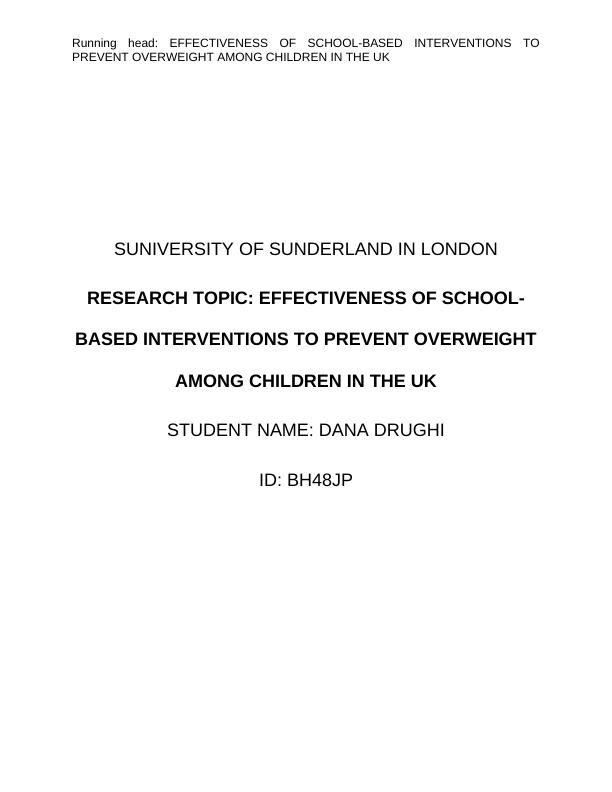
1
EFFECTIVENESS OF SCHOOL-BASED INTERVENTIONS TO PREVENT
OVERWEIGHT AMONG CHILDREN IN THE UK
CHAPTER 1: INTRODUCTION TO THE RESEARCH
1.0 Introduction:
Obesity among children is a global problem; it is actually affecting 41 million children
aged under 5 years around the world (WHO, 2016). Childhood obesity with additional
economic and health effects is a very important predictor that causes obesity in
adulthood. The UK is no difference when it comes to excess weight among children.
Reportedly a quarter of 4- or 5-years old children have obesity in the UK (NHS, 2015a).
Furthermore, this proportion of obesity among children increases during the subsequent
six years; this increase is approximately from 9% to 19% (NHS, 2015b). As a result, this
is a critical issue that requires immediate preventive actions. This research paper aims
to critically analyse the effectiveness of school-based interventions in preventing obesity
among children. In order to achieve this aim, several literatures and frameworks will be
reviewed in this paper, based on this review, a research methodology will be decided for
further advancement in this topic.
1.1 Operational Definition:
Multiple systematic reviews have suggested that school-based interventions can
actually be effective in terms of reduction of the children proportions with obesity or
excess weight. Several school-based interventions were actually very effective in Body
Mass Index or BMI reduction among overweight children (McConnell-Nzunga et al.,
2018). Study designs and interventions based on heterogeneity actually precludes
conclusions about the combination of components that are likely to be effective.
Childhood obesity is also associated with several adverse health issues such as
EFFECTIVENESS OF SCHOOL-BASED INTERVENTIONS TO PREVENT
OVERWEIGHT AMONG CHILDREN IN THE UK
CHAPTER 1: INTRODUCTION TO THE RESEARCH
1.0 Introduction:
Obesity among children is a global problem; it is actually affecting 41 million children
aged under 5 years around the world (WHO, 2016). Childhood obesity with additional
economic and health effects is a very important predictor that causes obesity in
adulthood. The UK is no difference when it comes to excess weight among children.
Reportedly a quarter of 4- or 5-years old children have obesity in the UK (NHS, 2015a).
Furthermore, this proportion of obesity among children increases during the subsequent
six years; this increase is approximately from 9% to 19% (NHS, 2015b). As a result, this
is a critical issue that requires immediate preventive actions. This research paper aims
to critically analyse the effectiveness of school-based interventions in preventing obesity
among children. In order to achieve this aim, several literatures and frameworks will be
reviewed in this paper, based on this review, a research methodology will be decided for
further advancement in this topic.
1.1 Operational Definition:
Multiple systematic reviews have suggested that school-based interventions can
actually be effective in terms of reduction of the children proportions with obesity or
excess weight. Several school-based interventions were actually very effective in Body
Mass Index or BMI reduction among overweight children (McConnell-Nzunga et al.,
2018). Study designs and interventions based on heterogeneity actually precludes
conclusions about the combination of components that are likely to be effective.
Childhood obesity is also associated with several adverse health issues such as
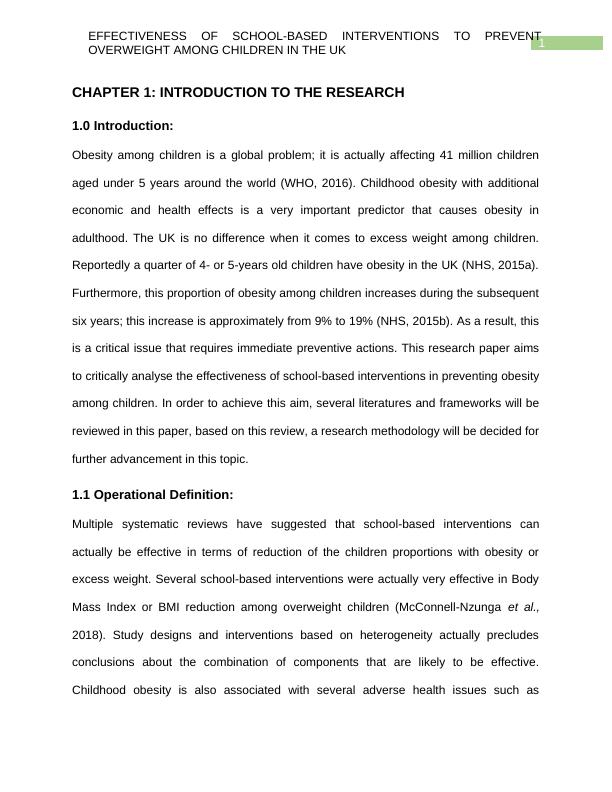
2
EFFECTIVENESS OF SCHOOL-BASED INTERVENTIONS TO PREVENT
OVERWEIGHT AMONG CHILDREN IN THE UK
diabetes, asthma, hypertension, and negative self-image during childhood, sleep
disorders, and so on (Nishtar et al., 2016). Overall, multicomponent interventions, food
and physical activities, support from teachers and extended home and community
activities are most likely to be associated with the concrete and positive results. Few
key terms used in this research are defined below:
Childhood obesity: Childhood obesity can be referred as the condition where the child
is overweight in relation to his or her age (Turner et al., 2015). This can cause some
serious impacts on the children such as diabetes, excessive cholesterol, high blood
pressure and many more.
BMI: BMI can be defined by a value which is the derivation from the height and mass of
the person (McConnell-Nzunga et al., 2018). It is basically calculated by considering the
total square of the body height and generally expressed in kg/m²
School based intervention: School based intervention is the program to reduce the
issues in the children related to the body image, eating habit and many more to provide
the healthy lifestyle (Micha et al., 2018).
1.2 Background:
Prevalence of obesity and overweight is alarmingly increasing worldwide. Based on the
collected data, obesity and overweight tendencies among the children is very common.
Around a quarter of children aged within the five years old bracket has obesity tendency
(Fitzsimons and Pongiglione, 2019). There are several causal factors that are
associated with this problem among children. The most common and also modifiable
ones are related to their regular diets, as well as physical activity behaviours. Unhealthy
EFFECTIVENESS OF SCHOOL-BASED INTERVENTIONS TO PREVENT
OVERWEIGHT AMONG CHILDREN IN THE UK
diabetes, asthma, hypertension, and negative self-image during childhood, sleep
disorders, and so on (Nishtar et al., 2016). Overall, multicomponent interventions, food
and physical activities, support from teachers and extended home and community
activities are most likely to be associated with the concrete and positive results. Few
key terms used in this research are defined below:
Childhood obesity: Childhood obesity can be referred as the condition where the child
is overweight in relation to his or her age (Turner et al., 2015). This can cause some
serious impacts on the children such as diabetes, excessive cholesterol, high blood
pressure and many more.
BMI: BMI can be defined by a value which is the derivation from the height and mass of
the person (McConnell-Nzunga et al., 2018). It is basically calculated by considering the
total square of the body height and generally expressed in kg/m²
School based intervention: School based intervention is the program to reduce the
issues in the children related to the body image, eating habit and many more to provide
the healthy lifestyle (Micha et al., 2018).
1.2 Background:
Prevalence of obesity and overweight is alarmingly increasing worldwide. Based on the
collected data, obesity and overweight tendencies among the children is very common.
Around a quarter of children aged within the five years old bracket has obesity tendency
(Fitzsimons and Pongiglione, 2019). There are several causal factors that are
associated with this problem among children. The most common and also modifiable
ones are related to their regular diets, as well as physical activity behaviours. Unhealthy
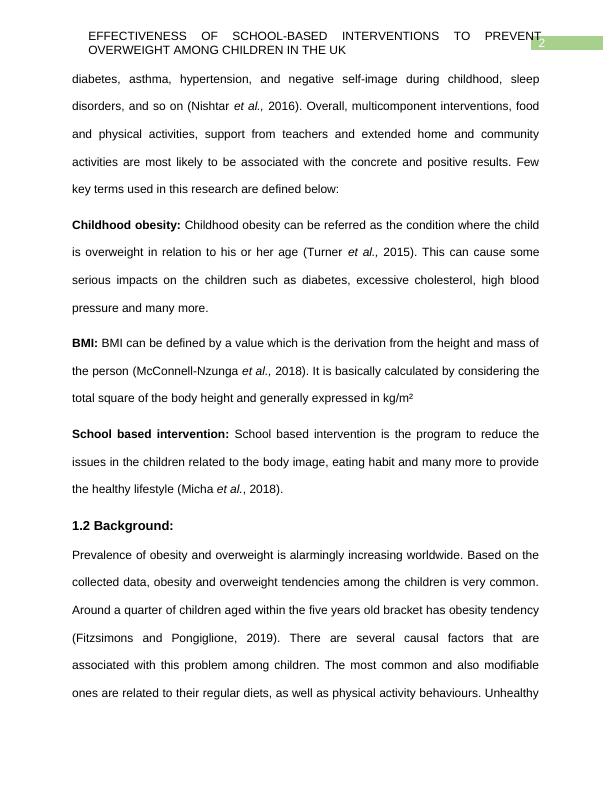
3
EFFECTIVENESS OF SCHOOL-BASED INTERVENTIONS TO PREVENT
OVERWEIGHT AMONG CHILDREN IN THE UK
diets and decreasing physical activities among the kids are actually increasing their BMI
(Nuttall, 2015). As the prior discussed statistics were constructed by several respective
authorities, this obesity tendencies and obesity-associated problems are indeed critical
for these children. (Hughes, 2018).
1.3. Problem Statement:
Childhood obesity is classified to be a major threat to public health and wellbeing. The
problem is not just in the context of the UK but also worldwide. Though, this current
research paper is focusing on the childhood obesity problem in the UK. Prevalence of
childhood obesity in the UK has significantly increased over the past few decades.
Based on the report published by the UK's National Health Service or NHS that 20.2%
of children measured during their study were obese (NHS, 2019b). Yet, the first annual
report by NHS reported only 2.4% during 2006. Furthermore, more than 26,000 children
that are around 4.4% of the studied children were severely obese. According to the
World Obesity Federation, 250 million school-aged children will be obese by 2030.
According to a report published by the UK chief medical officer Davies (2019), the
reason behind this increasing trend in childhood obesity is unhealthy diets and
increasing fast food consumption. These unhealthy diets and insufficient physical
activities are the reason behind some diseases among children such as
osteoarthritis,diabetes, heart diseases (Lopes et al., 2018).This subject matter has been
chosen for this research because of multiple reasons; every adult in the UK has a
responsibility to point out the extent of obesity in the children's prevalence in the
country. Furthermore, and several studies have already shown the severity of this
problem among the children in the UK. This is why constructing a research study based
EFFECTIVENESS OF SCHOOL-BASED INTERVENTIONS TO PREVENT
OVERWEIGHT AMONG CHILDREN IN THE UK
diets and decreasing physical activities among the kids are actually increasing their BMI
(Nuttall, 2015). As the prior discussed statistics were constructed by several respective
authorities, this obesity tendencies and obesity-associated problems are indeed critical
for these children. (Hughes, 2018).
1.3. Problem Statement:
Childhood obesity is classified to be a major threat to public health and wellbeing. The
problem is not just in the context of the UK but also worldwide. Though, this current
research paper is focusing on the childhood obesity problem in the UK. Prevalence of
childhood obesity in the UK has significantly increased over the past few decades.
Based on the report published by the UK's National Health Service or NHS that 20.2%
of children measured during their study were obese (NHS, 2019b). Yet, the first annual
report by NHS reported only 2.4% during 2006. Furthermore, more than 26,000 children
that are around 4.4% of the studied children were severely obese. According to the
World Obesity Federation, 250 million school-aged children will be obese by 2030.
According to a report published by the UK chief medical officer Davies (2019), the
reason behind this increasing trend in childhood obesity is unhealthy diets and
increasing fast food consumption. These unhealthy diets and insufficient physical
activities are the reason behind some diseases among children such as
osteoarthritis,diabetes, heart diseases (Lopes et al., 2018).This subject matter has been
chosen for this research because of multiple reasons; every adult in the UK has a
responsibility to point out the extent of obesity in the children's prevalence in the
country. Furthermore, and several studies have already shown the severity of this
problem among the children in the UK. This is why constructing a research study based
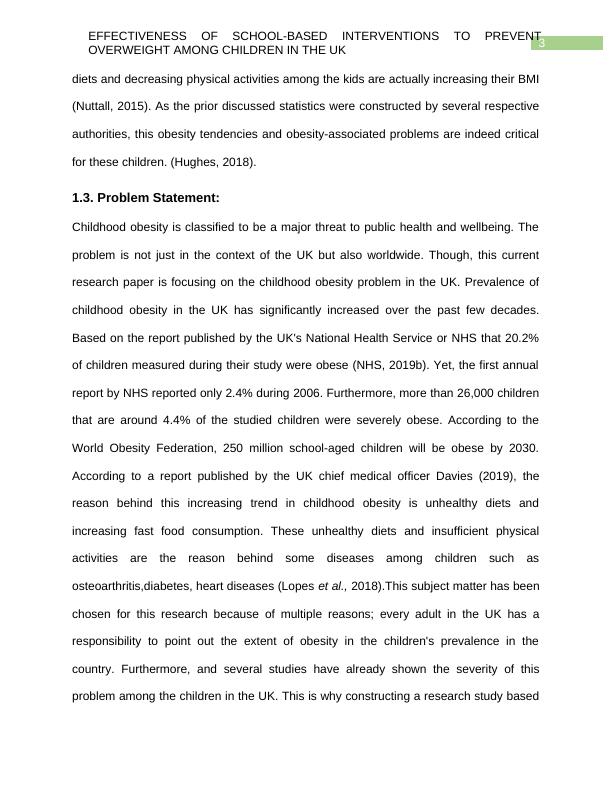
4
EFFECTIVENESS OF SCHOOL-BASED INTERVENTIONS TO PREVENT
OVERWEIGHT AMONG CHILDREN IN THE UK
on the school-based intervention programs points out the necessity of viable strategy
implementation and finding a potential solution (Hung et al., 2015). This research also
focuses on the outcome assessment for their effectiveness as well. Overall, evaluation
of the short-term effects of an education-based intervention and based on the result,
longitudinal school-based educational interventions can be recommended for long-term
impact on childhood obesity prevention.
1.5. Justification of Research:
As several recent studies are reporting childhood obesity is increasing in the UK, other
obesity-associated issues or diseases are also on the rise. As a result, heart diseases
and strokes are now very common among young people because of this obese
childhood problems. Furthermore, diabetes, asthma, sleep apnea and osteoarthritis are
also reportedly the obesity-associated diseases among the children. As per NHS,
insufficient physical activity and poor diet is the reason behind this obesity issue.
1.6. Significance of the Research:
WHO has cited childhood obesity to be the most serious health challenges for public
wellbeing. Childhood obesity examination programs are necessary and also such
examinations reports about several organs in the body, this, as a result, can also
identify the risk of other diseases in the future as well (Reinehr, 2018). Effectiveness of
these programs means, attaining the significant positive behaviour change among the
children following nutritional knowledge gained from obesity education. Considering the
association of obesity and lifestyle, this study is important as it will focus on the
attribution of a decisive role to achieve voluntary changes in children's behaviour.
EFFECTIVENESS OF SCHOOL-BASED INTERVENTIONS TO PREVENT
OVERWEIGHT AMONG CHILDREN IN THE UK
on the school-based intervention programs points out the necessity of viable strategy
implementation and finding a potential solution (Hung et al., 2015). This research also
focuses on the outcome assessment for their effectiveness as well. Overall, evaluation
of the short-term effects of an education-based intervention and based on the result,
longitudinal school-based educational interventions can be recommended for long-term
impact on childhood obesity prevention.
1.5. Justification of Research:
As several recent studies are reporting childhood obesity is increasing in the UK, other
obesity-associated issues or diseases are also on the rise. As a result, heart diseases
and strokes are now very common among young people because of this obese
childhood problems. Furthermore, diabetes, asthma, sleep apnea and osteoarthritis are
also reportedly the obesity-associated diseases among the children. As per NHS,
insufficient physical activity and poor diet is the reason behind this obesity issue.
1.6. Significance of the Research:
WHO has cited childhood obesity to be the most serious health challenges for public
wellbeing. Childhood obesity examination programs are necessary and also such
examinations reports about several organs in the body, this, as a result, can also
identify the risk of other diseases in the future as well (Reinehr, 2018). Effectiveness of
these programs means, attaining the significant positive behaviour change among the
children following nutritional knowledge gained from obesity education. Considering the
association of obesity and lifestyle, this study is important as it will focus on the
attribution of a decisive role to achieve voluntary changes in children's behaviour.
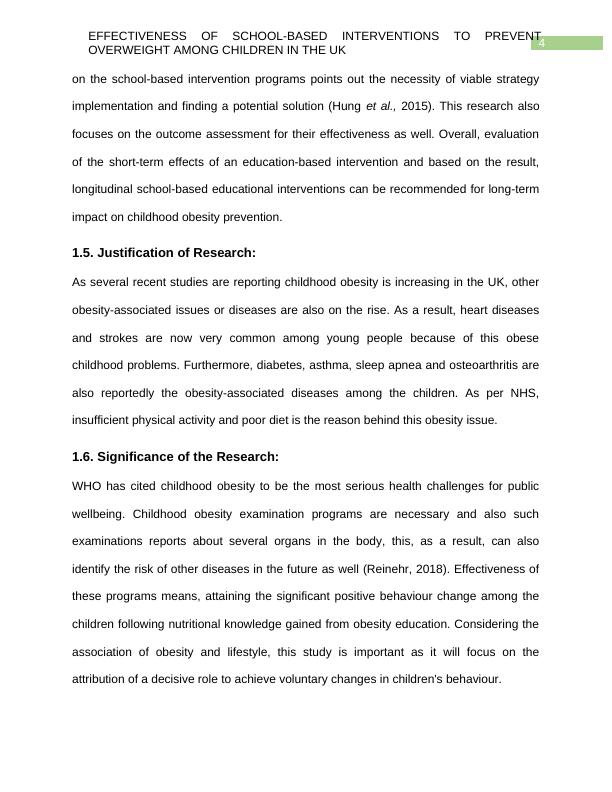
5
EFFECTIVENESS OF SCHOOL-BASED INTERVENTIONS TO PREVENT
OVERWEIGHT AMONG CHILDREN IN THE UK
1.7 Summary:
This introduction chapter has focused on the main coverage of current research paper.
This overview has presented the research subject and also presented the importance of
the research by the establishment of the research subject using several statistics. By
assessing the value of the problem, this chapter has also focused on the significance of
this research paper as well.
EFFECTIVENESS OF SCHOOL-BASED INTERVENTIONS TO PREVENT
OVERWEIGHT AMONG CHILDREN IN THE UK
1.7 Summary:
This introduction chapter has focused on the main coverage of current research paper.
This overview has presented the research subject and also presented the importance of
the research by the establishment of the research subject using several statistics. By
assessing the value of the problem, this chapter has also focused on the significance of
this research paper as well.
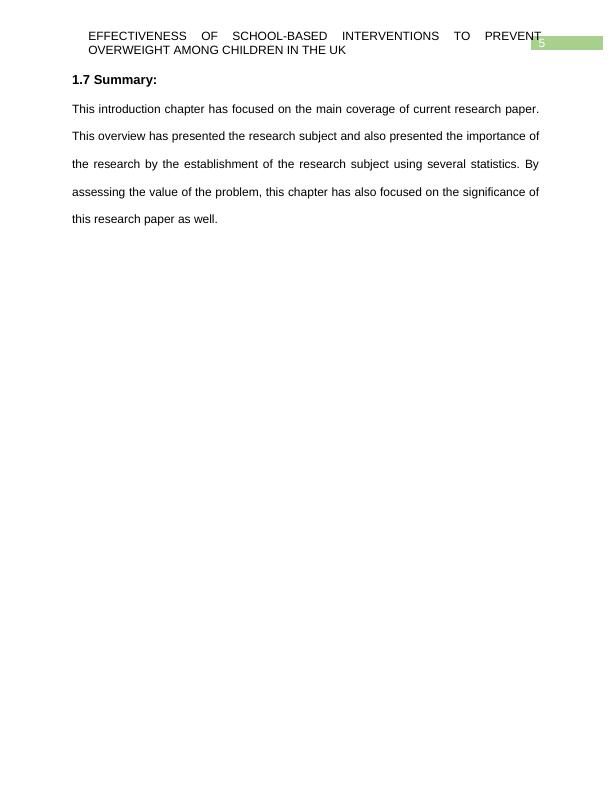
6
EFFECTIVENESS OF SCHOOL-BASED INTERVENTIONS TO PREVENT
OVERWEIGHT AMONG CHILDREN IN THE UK
CHAPTER 2: LITERATURE REVIEW
2.0 Introduction:
The objective of this chapter is the establishment of the effective intervention of
childhood obesity programs, as a part of the feasibility study. This chapter will focus on
the theoretical framework concepts in relation to this current study. It starts with broad
literature reviews on this topic; this review will focus on the identification of the root
causes or contributing factors, strategic deployment of school-based programs and the
effectiveness of such programs. Furthermore, this chapter will also discuss the
theoretical frameworks or theories in terms of childhood obesity and will critically review
the school-based interventions and the role of such programs. Literature reviews allow
to highlight gaps in previous research, obtain critical observations and also allows the
researcher to re-focus on the study topic.
Relevant literature was extracted and reviewed by evaluating them using a checklist.
The guidelines of this checklist were to evaluate the quality of the research methods
used in those studies. Key components were the data collection methods, appropriate
analysis methods in context to the current study.
2.1. Determinants of childhood obesity in the UK:
The reviewed literature never focused on indicating a specific cause behind childhood
obesity; rather, they documented various possible reasons. Based on the study
performed by Wilkie et al. (2018), the most common causes behind obesity among
children are genetic, lack of physical activity, unhealthy dietary patterns or combination
EFFECTIVENESS OF SCHOOL-BASED INTERVENTIONS TO PREVENT
OVERWEIGHT AMONG CHILDREN IN THE UK
CHAPTER 2: LITERATURE REVIEW
2.0 Introduction:
The objective of this chapter is the establishment of the effective intervention of
childhood obesity programs, as a part of the feasibility study. This chapter will focus on
the theoretical framework concepts in relation to this current study. It starts with broad
literature reviews on this topic; this review will focus on the identification of the root
causes or contributing factors, strategic deployment of school-based programs and the
effectiveness of such programs. Furthermore, this chapter will also discuss the
theoretical frameworks or theories in terms of childhood obesity and will critically review
the school-based interventions and the role of such programs. Literature reviews allow
to highlight gaps in previous research, obtain critical observations and also allows the
researcher to re-focus on the study topic.
Relevant literature was extracted and reviewed by evaluating them using a checklist.
The guidelines of this checklist were to evaluate the quality of the research methods
used in those studies. Key components were the data collection methods, appropriate
analysis methods in context to the current study.
2.1. Determinants of childhood obesity in the UK:
The reviewed literature never focused on indicating a specific cause behind childhood
obesity; rather, they documented various possible reasons. Based on the study
performed by Wilkie et al. (2018), the most common causes behind obesity among
children are genetic, lack of physical activity, unhealthy dietary patterns or combination
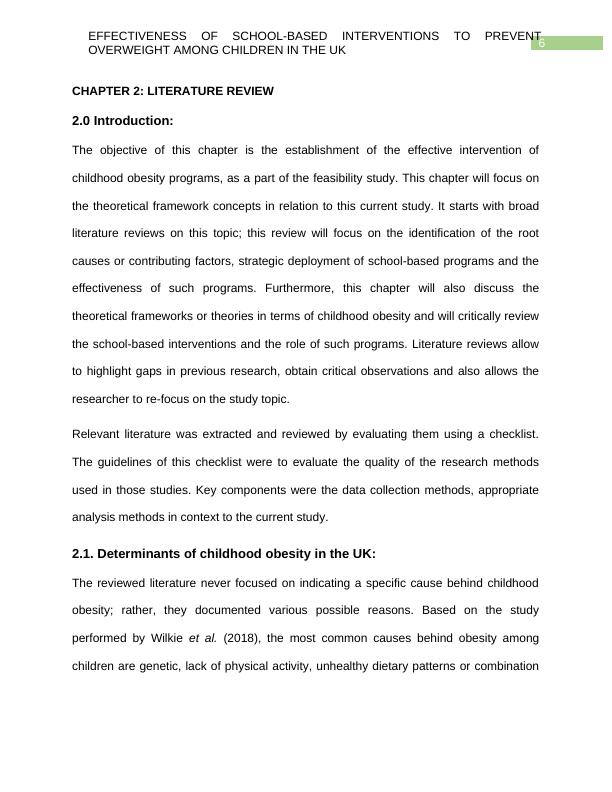
7
EFFECTIVENESS OF SCHOOL-BASED INTERVENTIONS TO PREVENT
OVERWEIGHT AMONG CHILDREN IN THE UK
of these aforementioned factors. The National Health Services of UK has categorised
the childhood obesity causes to be genetic, social and behavioural.
Genetical Factors:The study by Hart (2018) explains that a child born to a family with a
history of overweightness is more prone to become obese as they are genetically
predisposed to such condition. This is why hormonal disorders are also known to
predispose the obesity problem to a child. There are two types of causes come under
genetical factors. The first one is mutation in a single gene in the leptin- melanocortin
pathway. The second one is the effect of multiple genes, which result in the promotion
of weight gaining.
Social or Environmental Factors:Based on the research study by Manioc et al.
(2018), social or environmental factors are the actions that are promoting the increased
consumption of unhealthy and fast foods, furthermore the discouragement activities
such as awareness advertisements and encouraging awareness for proper dietary
charts. Also, limited access to healthy, affordable foods that attract the children, high
energy-dense food availability and lack of appealing places for playing are also the root
cause behind the obesity among UK children.
Behavioural Factors: According to Bates et al. (2018), obesity causing behavioural
factors are the dietary patterns that these children and their patents are following, lack
of physical activity, inadequate sleep, forced educational pressures by the school and
parents. These factors are actually taking these children towards obesity problems.
According to Knai et al., (2016), with the increased academic pressure on this very
young demographic from both the institutes and parents they involve in lesser physical
activities. As a result, they are now more prone to obesity. Furthermore, increased
EFFECTIVENESS OF SCHOOL-BASED INTERVENTIONS TO PREVENT
OVERWEIGHT AMONG CHILDREN IN THE UK
of these aforementioned factors. The National Health Services of UK has categorised
the childhood obesity causes to be genetic, social and behavioural.
Genetical Factors:The study by Hart (2018) explains that a child born to a family with a
history of overweightness is more prone to become obese as they are genetically
predisposed to such condition. This is why hormonal disorders are also known to
predispose the obesity problem to a child. There are two types of causes come under
genetical factors. The first one is mutation in a single gene in the leptin- melanocortin
pathway. The second one is the effect of multiple genes, which result in the promotion
of weight gaining.
Social or Environmental Factors:Based on the research study by Manioc et al.
(2018), social or environmental factors are the actions that are promoting the increased
consumption of unhealthy and fast foods, furthermore the discouragement activities
such as awareness advertisements and encouraging awareness for proper dietary
charts. Also, limited access to healthy, affordable foods that attract the children, high
energy-dense food availability and lack of appealing places for playing are also the root
cause behind the obesity among UK children.
Behavioural Factors: According to Bates et al. (2018), obesity causing behavioural
factors are the dietary patterns that these children and their patents are following, lack
of physical activity, inadequate sleep, forced educational pressures by the school and
parents. These factors are actually taking these children towards obesity problems.
According to Knai et al., (2016), with the increased academic pressure on this very
young demographic from both the institutes and parents they involve in lesser physical
activities. As a result, they are now more prone to obesity. Furthermore, increased
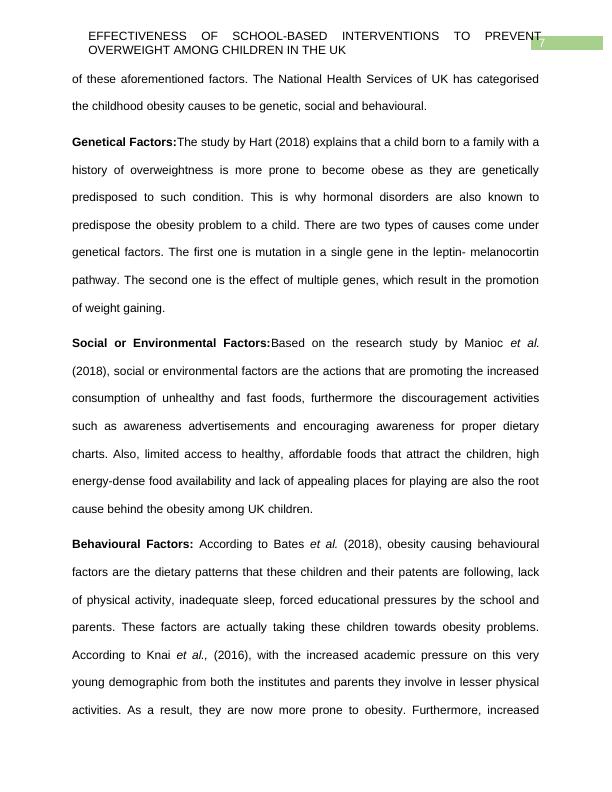
End of preview
Want to access all the pages? Upload your documents or become a member.
Related Documents
Assignment on Effectiveness of School-based Interventions to Preventlg...
|55
|12765
|17
Childhood obesity is an indicator of adulthoodlg...
|19
|5028
|31
Concept Map | Community Health Promotionlg...
|10
|2407
|79
Childhood Obesity: Key Messages and Recommendationslg...
|2
|2724
|94
Childhood obesity in Australialg...
|14
|3912
|288
Prevention of Obesity in Children Management Analysis 2022lg...
|5
|1126
|12
